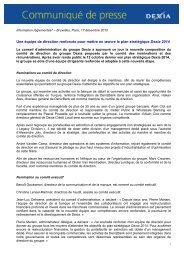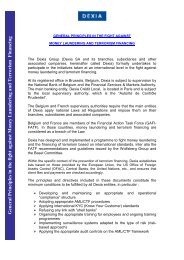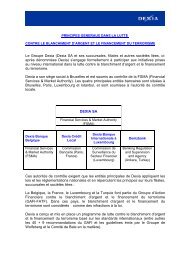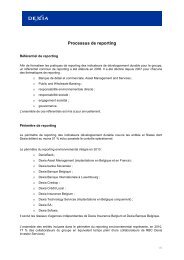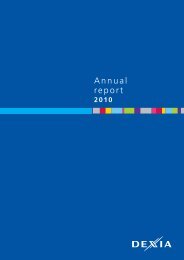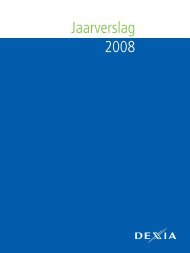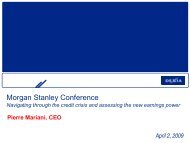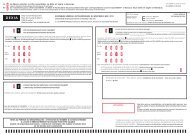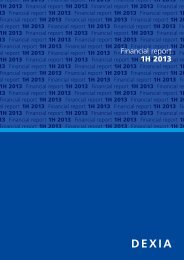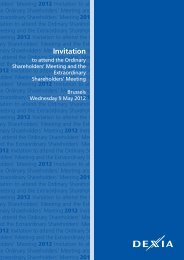Annual report 2009 - Dexia.com
Annual report 2009 - Dexia.com
Annual report 2009 - Dexia.com
- No tags were found...
You also want an ePaper? Increase the reach of your titles
YUMPU automatically turns print PDFs into web optimized ePapers that Google loves.
Notes to the consolidated fi nancial statements(Structural) Foreign exchangeAlthough <strong>Dexia</strong>’s <strong>report</strong>ing currency is the euro, assets, liabilities,in<strong>com</strong>e and expenses are also denominated in othercurrencies. The Group ALCo decides on the hedges to beimplemented in order to reduce both earnings volatilityresulting from the structural foreign exchange risk and thevolatility of the solvency ratio related to exposures (credit,participations) in foreign currencies.Insurance <strong>com</strong>panies and pension fundsSpecific <strong>report</strong>s on insurance <strong>com</strong>panies and pension fundsare presented to the Group ALCo, covering interest rate,inflation and equity risk factors. Risk indicators are calculatedon the basis of a Group harmonised risk methodology <strong>com</strong>plementedwith specific risk management factors.3.3.4. LiquidityStrong improvement of the liquidity profileSignificant progress was made in <strong>2009</strong> in terms of liquidityconsolidation.To recall, a guarantee on a major proportion of <strong>Dexia</strong>’s shortand long-term funding was granted in October 2008 by theBelgian, French and Luxembourg States. With an endorsementsigned on 14 October <strong>2009</strong>, this guarantee wasextended until 31 October 2010 and the following changeswere made to the mechanism:• the cap on guaranteed outstandings was lowered from EUR150 billion to EUR 100 billion;• the maturity of new long-term debts issued was extendedto a maximum of four years.In addition, since 16 October <strong>2009</strong>, <strong>Dexia</strong> has waived thebenefit of the guarantee for all new contracts with a maturitybelow one month and for all new contracts with no fixedmaturity. <strong>Dexia</strong> could easily replace guaranteed with nonguaranteedfunding.On 30 October <strong>2009</strong>, the European Commission provisionallyauthorised the extension of this funding guarantee until theend of February 2010. Then, within the context of the agreementwith the European Commission on 5 February 2010,an early exit from the guarantee mechanism was announced,the details of which are given in the chapter “<strong>2009</strong> and early2010 highlights” on page 13 of this annual <strong>report</strong>.In <strong>2009</strong>, the Group issued a total of EUR 45.7 billion ofmedium and long-term funds (with an average maturity of 5years). The portion of debt not covered by the State guaranteewas 51%, rising constantly over the year.This good performance was made possible by:• the reopening of the covered bond market in the secondquarter <strong>2009</strong>, which allowed a total of EUR 13.0 billion incovered bonds to be issued in <strong>2009</strong> via its three issuers <strong>Dexia</strong>Municipal Agency, <strong>Dexia</strong> Kommunalbank Deutschland and<strong>Dexia</strong> Lettres de Gage;• the renewed access to unsecured non-guaranteed funding,particularly from the third quarter <strong>2009</strong>, reflected by a volumeof medium and long-term unsecured non-guaranteedissues of EUR 10.3 billion in <strong>2009</strong>.The short-term liquidity profile was also improved considerablyin the second half of the year with the gradual increase offunding raised on the bilateral and triparty repo market andthe improved access to non-guaranteed short-term liquidity.Globally, the Group’s short-term funding needs fell sharplyin <strong>2009</strong> by virtue of the active deleveraging policy initiatedby the Group since the fourth quarter 2008 (sale of bondswithin the portfolio in run-off for an amount of EUR 15 billionin <strong>2009</strong>, with a maturity of 4.5 years) and the strongmomentum of the long-term issue programme.The result of all these elements <strong>com</strong>bined was a sharp reductionof guaranteed short and long-term debts. They amountedto EUR 50.4 billion as at 31 December <strong>2009</strong>, <strong>com</strong>pared to amaximum of EUR 95.8 billion in May <strong>2009</strong>.In 2010, liquidity consolidation efforts will continue with theprincipal aim of fully exiting the guarantee mechanism at thelatest on 30 June 2010, which means that no new governmentguaranteed debt will be issued by the Group after this date.Liquidity risk management<strong>Dexia</strong>'s approach to liquidity risk management was reviewedin the light of the financial and liquidity crisis. It is basedon the general principle that <strong>Dexia</strong>'s future funding needsshould never exceed its proven covered funding capacity. Inother words, <strong>Dexia</strong> ensures that its short-term funding needscan always be covered by the use of liquid assets in the interbankmarket.<strong>Dexia</strong> ensures that it maintains a liquidity buffer which is sufficientto face cash exits under different scenarios. That liquiditybuffer is formed of freely available securities accepted asunderlying by the central banks to which <strong>Dexia</strong> has access.Future funding needs are assessed dynamically and <strong>com</strong>prehensively,taking into account liquidity needs arising from currentand programmed on and off-balance-sheet transactions.Its covered funding capacity is determined conservatively, takingthe lessons from the current crisis into consideration. Theadequacy of <strong>Dexia</strong>'s future liquidity needs with its coveredfunding capacity is tested under an ungoing scenario as wellas under a variety of severe stress scenarios including bankspecificand market stresses and even a <strong>com</strong>bination of both.Short-term funding needs are monitored on a daily basis.Longer-term funding needs (up to three years) are monitoredon a monthly basis. More generally, liquidity risk managementis at the very heart of the definition of <strong>Dexia</strong>'s triennial financialplan. The result of that monitoring is presented weeklyto the FLC, which determines the major orientations of theliquidity management. This framework is back-tested andupdated regularly in accordance with best risk managementpractices and integrating all the local regulatory constraints.The diversity of <strong>Dexia</strong>'s funding sources is a key-mitigant ofits liquidity risk. <strong>Dexia</strong>'s principal funding sources are:• retail bank deposits (essentially in Belgium, Luxembourgand Turkey);• long-term funding:- covered bonds;- unsecured bonds, benefiting from the State guarantee ornot (notably bonds distributed via the <strong>Dexia</strong> networks);• short-term funding:- bilateral and triparty repo transactions;- central bank tender operations;- a wide variety of wholesale short-term unsecured fundingsources, some of which benefit from the State guarantee.<strong>Dexia</strong>'s liquidity risk is managed using a centralised approach.Although liquidity positions are managed by the differententities of the Group, the <strong>Dexia</strong> funding strategy is managedon a centralised and integrated basis.<strong>Annual</strong> <strong>report</strong> <strong>2009</strong> <strong>Dexia</strong> 123Management <strong>report</strong>Consolidatedfinancial statements<strong>Annual</strong> financial statementsAdditional information



